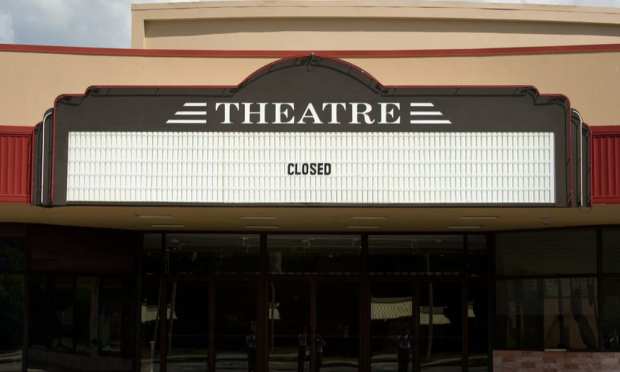Movie Theaters Go Big To Bring Customers Back

In case you missed it, PYMNTS reported that in the week of April 20, weekend movie box-office grosses came in at just under $34,000 total. For the entire nation. “That is not a typo,” our coverage reassured readers, while adding the equally bizarre fact that “all of those ticket sales came from just one place” – the Ocala Drive-In of Ocala, Florida.
Welcome to movie-going in the age of the novel coronavirus. While drive-in mania is having a moment during the COVID summer, that’s not a solution for America’s theater chains.
The sector has been undergoing steady change in recent years, as the 1990s’ ideas around “home theater” came true with affordable big-screen HDTVs and streaming services offering every bit of filmed entertainment imaginable, piped straight into private homes where there’s no COVID, no public restrooms, no one talking two rows in front of you and no overpriced popcorn.
Years of evolution in hardware and broadband have compounded the current problems of movie chains that have been shuttered for months. AMC Entertainment Holdings announced this week that it “expects to open approximately two-thirds of its more than 600 U.S. theater locations” by Sept. 3, with plans for celebratory events – like bringing back 1920s ticket prices of 15 cents for the day – to attract audiences back to theatrical movie-going.
It’s an intermission without a clear endpoint, as things now stand.
The Plot Thickens
As a bellwether of the category, AMC is being closely monitored by market watchers. PYMNTS reported in June on the chain’s SEC filing, stating that “we have never previously experienced a complete cessation of our operations, and as a consequence, our ability to be predictive is uncertain.”
PYMNTS’ research documenting the effects of the pandemic began in March, as the national mood turned grim and there were far more unknowns in the health and economic equations. What we found were four distinct consumer personas that had shifted to digital due to COVID-19, among them the group we call “safety shifters.”
“Safety shifters are the most worried about suffering negative impacts of the pandemic, with 75.7 percent reporting they are ‘very’ or ‘extremely’ concerned about them,” according to The Great Reopening: Shifting Preferences edition of PYMNTS’ COVID-19 report series.
“This compares to 60.4 percent of all consumers who say the same. Social and office shifters are also more worried about such impacts than the average consumer, with 68.2 percent and 62.9 percent saying they are ‘very’ or ‘extremely’ concerned, respectively.”
Safety shifters have voiced a powerful COVID aversion since PYMNTS’ first pandemic poll on March 17. At that time, 72.3 percent of “safety shifters” reported feeling “very” or “extremely concerned,” compared to 57 percent of all consumers surveyed.
The bottom line is that large segments of the population now evince a strong dislike of crowds in closed-in spaces, or even open-air stadiums for that matter. It’s a major issue that theater chains will need to overcome, and new plans for seating and sanitizing are debuting now, too.
Brand-New Competitors, Same Old Pricing Pressures
AMC’s pricing promotion is a clever way to sell seats to upcoming theatrical debuts, including “Unhinged,” “The New Mutants” and “Tenet,” all coming to AMC theaters this summer.
Lowering ticket and concession prices is a risky strategy for AMC and other operators, as snacks generate most of the actual profits. Seating will be COVID-style for a while, meaning that chains will be way off revenue projections as they have fewer, cheaper seats to sell.
Companies have tried value-pricing models for theatrical movies, as did the now-defunct MoviePass, which winked out of existence early this year. “It’s never a good idea to lower prices and then lose money on subscribers, which is what MoviePass did when it dropped the service’s price from $50 to the famed $10,” PYMNTS reported. “Net losses doubled in 2018 to about $329 million on sales of $232 million.” Uber-like surge pricing also failed to save the ticket service.
Whether AMC will pursue discounts, price increases or another hybrid movie-going model remains to be seen, as the chain seeks models compatible with COVID-era behaviors.
Movie chains face an uphill battle – not just against COVID paranoia, but also against the entertainment conglomerates that are moving on their turf with streaming sizzle.
Theme parks are hurting, but Disney’s new Disney+ streaming TV service is going gangbusters. “Disney announced that its streaming empire – Disney+, Hulu and ESPN+ — has grown to about 100 million subscribers worldwide. The bulk of that membership comes from the recently launched Disney+, which alone has about 60.5 million subscribers — a goal that it met four years earlier than first expected,” PYMNTS reported.
Then there’s Amazon’s new Watch Party feature, which allows as many as 100 Amazon Prime members to simultaneously stream content in a remote experience that simulates moviegoing.
